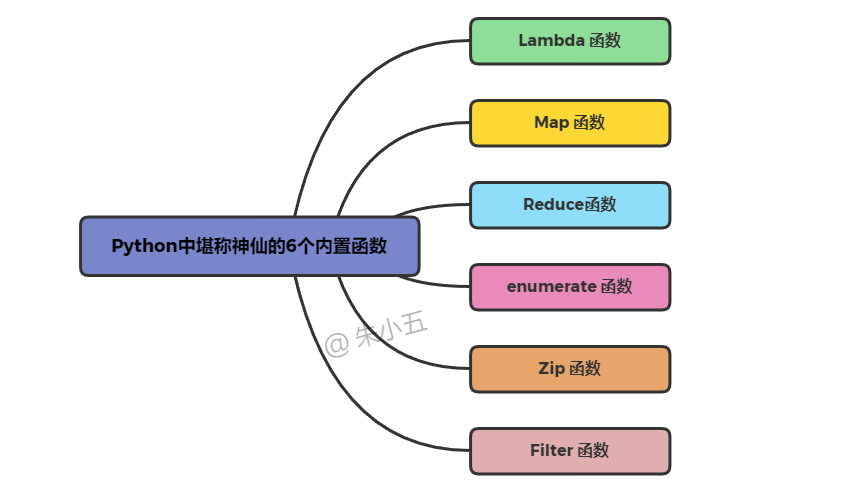python數(shù)字包含常用的內(nèi)置函數(shù)和模塊,比如pow()、abs()、floor()、int()等函數(shù),以及math、random等模塊。
1.1 pow()
pow(x,y)函數(shù)對(duì)應(yīng)的表達(dá)式x ** y
用法
pow(base, exp, mod=None)
描述
python的pow()函數(shù)為冪函數(shù)。pow(x,y,n)=xy%n,表示x的y次方,然后對(duì)結(jié)果取模。
入?yún)?/strong>
base:為底數(shù)。
exp:為指數(shù)。
mod:為取模。
示例
>>> pow(2,3),2**3
(8, 8)
>>> pow(2,3,2)
0
>>> pow(2,3,3)
2
1.2 abs()
python的abs()函數(shù)對(duì)數(shù)字進(jìn)行絕對(duì)值計(jì)算。
示例
>>> abs(-95.55)
95.55
1.3 sum()
python的sum()函數(shù)對(duì)序列進(jìn)行求和計(jì)算。
示例
>>> sum([1,2,3,4,5,])
15
1.4 min()和max()
python的min()函數(shù),求給定參數(shù)的最小值,max()函數(shù),求給定參數(shù)的最大值。
示例
>>> mlist=[1,2,3,4,5,6]
>>> min(mlist),max(mlist)
(1, 6)
>>> min(1,2,3,4,5,6),max(1,2,3,4,5,6)
(1, 6)
1.5 sin()
python的sin()函數(shù),求給定弧度的正弦值。需導(dǎo)入math模塊。
示例
>>> import math
>>> math.pi,math.e
(3.141592653589793, 2.718281828459045)
>>> math.sin(2*math.pi/180)
0.03489949670250097
1.6 sqrt()
python的sqrt()函數(shù),求給定數(shù)的平方根。需導(dǎo)入math模塊。
使用python的pow()函數(shù),冪表達(dá)式,也可以實(shí)現(xiàn)平方根的計(jì)算。
示例
>>> math.sqrt(2),math.sqrt(9)
(1.4142135623730951, 3.0)
>>> math.sqrt(9),pow(9,0.5),9**0.5
(3.0, 3.0, 3.0)
1.7 floor()
python的floor()函數(shù),對(duì)給定數(shù)值進(jìn)行向下取整,結(jié)果為整數(shù)。需導(dǎo)入math模塊。
示例
>>> import math
>>> math.floor(2.567),math.floor(-2.567),math.floor(-2)
(2, -3, -2)
1.8 trunc()
python的trunc()函數(shù),截取給定數(shù)字的整數(shù)部分,結(jié)果為整數(shù)。需導(dǎo)入math模塊。
示例
>>> import math
>>> math.trunc(2.567),math.trunc(-2.567),math.trunc(-2)
(2, -2, -2)
1.9 int()
python的int()函數(shù),對(duì)給定數(shù)字取整,向0的方向取,結(jié)果為整數(shù)。
示例
>>> int(2.567),int(-2.567),int(-2)
(2, -2, -2)
1.10 round()
python的round()函數(shù),對(duì)給定數(shù)字進(jìn)行四舍五入,保留位數(shù)后一位為5時(shí),奇進(jìn)偶不進(jìn)(即:第1:整數(shù)為奇數(shù)則進(jìn)位,為偶數(shù)不進(jìn)位;第2:整數(shù)為奇數(shù)時(shí),保留位數(shù)的后1位如果是5,且該位后有數(shù)字,則進(jìn)位。)
用法
round(number, ndigits=None)
描述
對(duì)給定數(shù)字number,按指定精度ndigits進(jìn)行四舍五入。
入?yún)?/strong>
number:需四舍五入的數(shù)字。
ndigits:小數(shù)點(diǎn)精度,即保留的小數(shù)位。默認(rèn)不保留小數(shù)。
示例
>>> round(2.567),round(-2.567),round(-2)
(3, -3, -2)
>>> round(2.1),round(2.5),round(2.6)
(2, 2, 3)
>>> round(-2.1),round(-2.5),round(-2.6)
(-2, -2, -3)
>>> round(2.5),round(3.5),round(-2.5),round(-3.5)
(2, 4, -2, -4)
>>> round(2.51),round(3.51)
(3, 4)
>>> round(2.567,2)
2.57
1.11 浮點(diǎn)數(shù)格式化
python數(shù)字的浮點(diǎn)數(shù)格式化,也可以對(duì)數(shù)字進(jìn)行四舍五入,保留指定小數(shù)位精度,也遵循奇進(jìn)偶不進(jìn)的原則。
用法
.nf:其中n為保留小數(shù)位數(shù),0不保留小數(shù)。
示例
>>> '%.1f,%.1f,%.1f' % (2.567,-2.567,-2)
'2.6,-2.6,-2.0'
>>> '{0:.2f},{1:.2f},{2:.2f}'.format(2.567,-2.567,-2)
'2.57,-2.57,-2.00'
>>> '{0:.0f},{1:.0f},{2:.0f},{3:.0f}'.format(2.5,3.5,-2.5,-3.5)
'2,4,-2,-4'
1.12 random()
python的random()函數(shù),可以隨機(jī)生成[0,1.0)的浮點(diǎn)數(shù)。需導(dǎo)入random模塊。
示例
>>> import random
>>> random.random(),random.random(),random.random()
(0.8334400340568541, 0.3180899796573453, 0.8120236865433559)
1.13 randint()
python的randint(a,b)函數(shù),可以隨機(jī)生成[a,b]的整數(shù)。需導(dǎo)入random模塊。
示例
>>> random.randint(1,10),random.randint(1,10),random.randint(1,10)
(8, 8, 3)
1.14 randchoice()
python的randchoice()函數(shù),可以在序列對(duì)象中,隨機(jī)挑選一項(xiàng)。需導(dǎo)入random模塊。
序列比例,字符串,列表,元組等。
示例
>>> s='梯閱線條軟件測(cè)試開發(fā)python學(xué)習(xí)random.choice()方法'
>>> random.choice(s),random.choice(s),random.choice(s)
('試', '(', 't')
-
編程語言
+關(guān)注
關(guān)注
10文章
1947瀏覽量
34832 -
函數(shù)
+關(guān)注
關(guān)注
3文章
4338瀏覽量
62774 -
python
+關(guān)注
關(guān)注
56文章
4800瀏覽量
84834
發(fā)布評(píng)論請(qǐng)先 登錄
相關(guān)推薦
關(guān)于Python巧妙而強(qiáng)大的內(nèi)置函數(shù)


python的os模塊有哪些常用函數(shù)?詳細(xì)概述
python的內(nèi)置函數(shù)詳細(xì)資料概述
Python的函數(shù)文件與模塊的程序說明

python的常用函數(shù)有哪些

python提供的68個(gè)內(nèi)置函數(shù)詳解
進(jìn)階必備的68個(gè)Python 內(nèi)置函數(shù)分析
推薦一個(gè)Python超級(jí)好用的內(nèi)置函數(shù)lambda

6個(gè)堪稱神仙的內(nèi)置函數(shù)





 python常用的內(nèi)置函數(shù)和模塊
python常用的內(nèi)置函數(shù)和模塊










評(píng)論